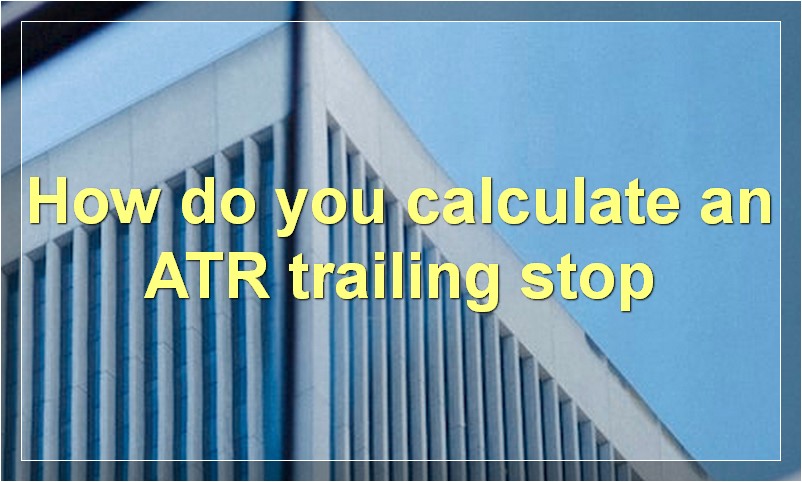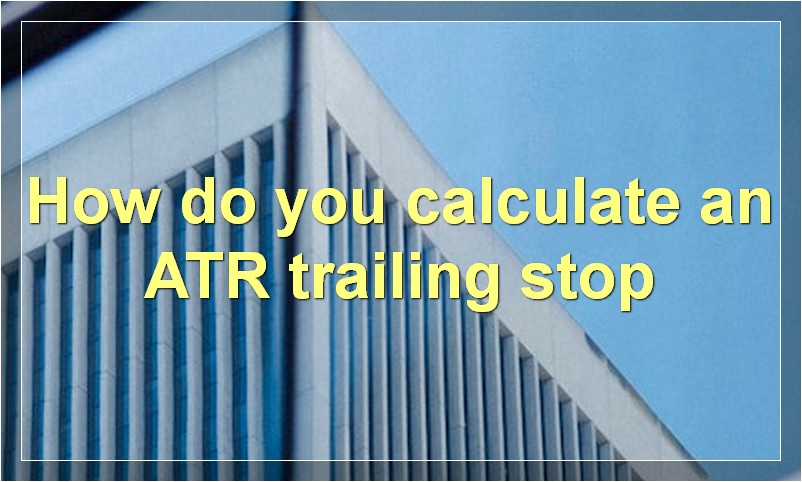If you’re looking to get started with ATR trailing stops, this is the article for you. We’ll explain the basics of how ATR trailing stops work and how you can use them to improve your trading.
What is an ATR trailing stop
An ATR trailing stop is a popular stop loss strategy used by many traders. The ATR trailing stop uses the Average True Range indicator to set the stop loss level. The ATR trailing stop is a dynamic stop loss that adjusts to the volatility of the market. Many traders use the ATR trailing stop because it can help lock in profits and protect against big losses.
How do you calculate an ATR trailing stop

Most traders use a fixed percentage of the ATR for their trailing stop. For example, if the ATR is 50 points and the trader is using a 2% trailing stop, then their stop would be moved to 1 point below the low of the previous bar once the bar closes lower than the high minus 2% ATR. So, in our example, the stop would be moved to 48 points below the high.
If a trader is using a trailing stop of 2% ATR, they are essentially saying that they are willing to give up 2% of the recent range in order to stay in a trade. This can be a good place to start, but some traders may find that they are giving up too much profit or getting stopped out too often. In these cases, it may be necessary to adjust the trailing stop percentage.
One thing to keep in mind is that the ATR is a volatile number and can fluctuate quite a bit. As such, don’t be surprised if your stops get hit more often than you’d like when using a fixed percentage of the ATR.
What is the difference between a standard stop-loss order and an ATR trailing stop
A standard stop-loss order is an order to sell a security when it reaches a certain price, known as the stop price. A trailing stop is a type of stop-loss order that automatically adjusts the stop price as the security’s price moves in favor of the position. The ATR trailing stop is based on the Average True Range indicator, which measures volatility.
Why might an ATR trailing stop be a more effective way to limit losses on a trade than a standard stop-loss order
An ATR trailing stop is a more effective way to limit losses on a trade than a standard stop-loss order for several reasons. First, an ATR trailing stop automatically adjusts to the volatility of the market, which means that it will tighten as the market becomes more volatile and loosen as the market becomes less volatile. This is important because it means that the stop will always be placed at a level that is appropriate for the current market conditions. Second, an ATR trailing stop is not static like a standard stop-loss order, which means that it will follow the price as it moves up or down. This is important because it means that the stop will always be placed at a level that is appropriate for the current market conditions. Finally, an ATR trailing stop is more difficult to manipulate than a standard stop-loss order, which means that it is more likely to limit losses in a volatile market.
How can you incorporate an ATR trailing stop into your trading strategy
An ATR trailing stop is a technical indicator that can be incorporated into your trading strategy in order to manage risk and protect profits. The ATR trailing stop is based on the Average True Range (ATR) indicator, which measures the volatility of a security. The ATR trailing stop sets a stop loss at a certain percentage below the most recent high (in an uptrending market), or above the most recent low (in a downtrending market). This percentage is based on the ATR value, which means that the stop loss will adjust as the ATR value changes.
The ATR trailing stop can be used in any market conditions, but it is especially useful in markets that are volatile or range-bound. This is because the ATR trailing stop can help you to lock in profits as the market fluctuates, while still allowing you to stay in the trade if the market continues in your favor.
To incorporate an ATR trailing stop into your trading strategy, you will need to calculate the ATR value for the security that you are trading. You can then use this ATR value to set your stop loss at a certain percentage below the most recent high (in an uptrending market), or above the most recent low (in a downtrending market). For example, if you are trading a stock with an ATR of 10 and you want to set a trailing stop loss, you could set your stop loss at 7% below the most recent high. This would mean that your stop loss would adjust as the stock’s price fluctuated, but it would always be 7% below the highest price that the stock reached.
If you are using an automated trading system, you may be able to set up your ATR trailing stop directly within the software. Alternatively, you can calculate the ATR value yourself and then place your order manually.
What are the potential drawbacks of using an ATR trailing stop

When it comes to using ATR trailing stops, there are a few potential drawbacks to be aware of. First and foremost, ATR trailing stops can sometimes be too aggressive, leading to premature exits from profitable trades. Secondly, ATR trailing stops can also get caught in choppy market conditions, resulting in false signals and whipsaws. Finally, because ATR trailing stops are based on volatility, they can sometimes be less effective in low-volatility markets.
If your broker does not offer ATR trailing stops, is there another way to set up a similar type of order
If you are looking for a broker who offers ATR trailing stops, there are a few things you can do. First, you can check with the National Futures Association to see if any member firms offer this type of order. Second, you can search online for “ATR trailing stop” to see if any online brokers offer this type of order. Finally, you can contact a broker directly to see if they offer this type of order.
What other indicators can be used in conjunction with an ATR trailing stop to further improve your trading results
There are a number of different indicators that can be used in conjunction with an ATR trailing stop. Some of these include the moving average, the relative strength index, and the MACD. Each of these indicators can provide valuable information about the direction of the market and can help to confirm trends. Using multiple indicators can help to improve your trading results as you will have a better understanding of the market.
Are there any special considerations you need to be aware of when using an ATR trailing stop in combination with a limit order
When using an ATR trailing stop in combination with a limit order, there are a few things you need to keep in mind. First, your stop will be based on the ATR, so it will be dynamic and could move up or down depending on market conditions. Second, you’ll need to set your limit order at a price that’s below the current market price, in order to ensure that you don’t get stopped out before your trade has a chance to reach its target. Finally, remember that you’re still subject to normal limit order rules, so if the market moves against you too quickly, your order may not be filled.
What is the best time frame to use when setting up an ATR trailing stop
The best time frame to use when setting up an ATR trailing stop is the daily timeframe. This ensures that the stop is triggered only when there is a significant move in price and not just noise.

